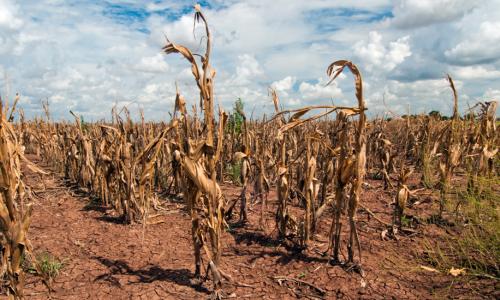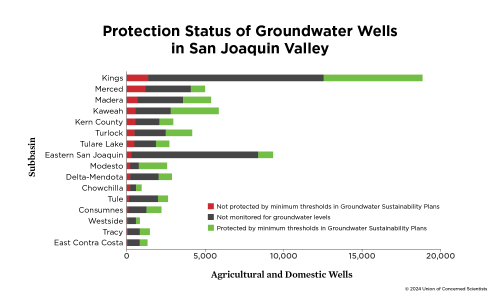Droughts can be caused by several factors, some natural, some related to human-caused climate change, others driven by a range of human activities.
The latest science says that as the climate warms, more precipitation is falling as rain rather than snow, snow is melting earlier, and evaporation and transpiration increase. All of these, combined with rising temperatures, can reduce water availability and increase water demands.
Changes in precipitation, rising temperatures, groundwater depletion, and human decisions are exacerbating drought conditions in many regions of the US. Much of the US Mountain West has experienced a decline in spring snowpack since the middle of the 20th century (2, 3). These declines are related to climate change because warming temperatures have reduced the amount of precipitation falling as snow (as opposed to rain) and shifted the timing of snowmelt. Earlier snowmelt, associated with these warmer temperatures, can lead to water supplies being out of sync with water demands. Increasingly, water is becoming available before it is needed and when it is hard to store, because reservoir water levels should be low during the rainy season to reduce flood risk.
When considering the relationship of drought to climate change, it is important to distinguish between weather and climate. Weather is a description of atmospheric conditions over a short time (i.e., days or weeks), while climate is how the atmosphere behaves over relatively long periods (i.e., years, decades, or longer). Climate change occurs over extended periods of time and manifest as changes in the patterns of weather events one would generally expect based on historical averages. While any one particular dry period in the past could have been dryer than a particular dry period now, dry periods in the western United States are increasing in prevalence, severity, and duration as our overall climate changes (4, 5).
In most of the country, rising temperatures associated with future climate change are expected to decrease surface soil moisture. Even without future changes in precipitation, this drying of soils is likely to cause future droughts across most of the United States to be stronger and longer lasting than those of the past (1).
While there is some variability in climate projections for western North America, most climate models project increased drought risk in the Southwest (6). The Southwest is considered one of the most sensitive regions globally to increased drought risk caused by climate change.
Within the last decade, droughts have affected many regions of the US, including the Southeast, the West, and the Midwest. In 2011, for example, Texas had the driest year on record since 1895. And in California, the most impactful recent drought--from 2012 to 2016-- affected agriculture, drinking water availability, and the ability to generate hydroelectric power, among many other aspects of life (7, 8).
Droughts are costly and affect people inside and outside the areas directly experiencing dry conditions, especially when a drought affects agricultural regions. Agriculture is the industry most affected by drought at the sector level; in California, the agriculture sector reported estimated losses of more than $3.8 billion from the 2012-2016 drought (7). Considering that California produces more than a third of the vegetables and two-thirds of the fruits and nuts sold in the United States, California’s drought had major national and international implications (9). Beyond direct economic impacts to a number of industries, drought can threaten drinking water supplies and ecosystems, increase wildfire risk, and contribute to increased food prices.
We must prepare for an increased risk of more frequent and severe drought conditions
Current responses to drought tend to focus on short-term measures, such as temporary water conservation and efficiency improvements, water transfers from one basin to another, and increased groundwater use during dry periods. However, with increased drought risk and continued unsustainable patterns of groundwater use, we must incorporate longer-term efforts that reduce vulnerability and increase resilience to more frequent, severe, and longer-lasting drought conditions. The single most important step in limiting drought risk is getting to “net negative” global CO2 emissions by midcentury, according to the Inter-Governmental Panel on Climate Change’s Special Report 1.5°C report. For its part, the US committed to reducing heat-trapping emissions by 50 to 52 percent (relative to 2005) by 2030.
We should:
- Act swiftly to reduce carbon emissions both nationally and as part of global efforts to reach net zero no later than 2050
- Reduce water use from every sector, especially agriculture, to sustainable levels
- Reduce acreages of crops that use the most water. This doesn’t mean eliminating those crops; it means reducing their area to sustainable levels, so that future generations can also have access to those commodities.
- Reduce acreages of perennial crops that compromise water demands for many years. Non-perennial crops can be planted during wet years and their acreage reduced during dry years to increase flexibility in water requirements.
- Improve regional monitoring and measuring of water supply and uses
- Target sources of surface and groundwater pollution that reduce clean water availability (for example, overuse of fertilizers and pesticides)
- Increase recycling and reuse of water, including by capturing and reusing stormwater, greywater, and wastewater
- Increase efforts to sustainably manage groundwater resources that act as a savings account during dry times. For example, recharging aquifers in wet seasons could serve as a buffer during dry periods
- Increase maintenance and modernize infrastructure to reduce leakages and health risk from old pipelines
- Update the operations of the infrastructure that comprises our water systems, such as reservoirs and conveyance canals. Many of these systems still operate with assumptions based on what our climate was like in the past and have not yet integrated advances in weather forecasting or updated climate information.
There are different types of drought
Generally speaking, a drought is a time when there isn't enough water to supply human and environmental needs. Drought often recalls images of cracked earth, dried-up streams, barren fields, or historically low water lines. In many vulnerable rural communities, overextraction of groundwater during droughts completely disrupts water access. Each of these images represents a different type of drought, and each type is measured differently.
We most often think about drought in relation to precipitation, assessing the degree of dryness (compared with a local or regional average) and the duration of the dry period. This is known as a meteorological drought, which is highly specific to a region as average precipitation may vary considerably across locations.
We can also think about hydrological drought, or how decreased precipitation affects streamflow, soil moisture, reservoir and lake levels, and groundwater recharge.
Farmers are most concerned with agricultural drought, which is when the available water supplies cannot meet crop-related water demands. Agricultural droughts can occur for various reasons, including low precipitation, the timing of water availability, decreased access to water supplies, or increased water demands from the sector. Responses from the agricultural sector to this type of drought often exacerbate other types of droughts. For instance, earlier snowmelt may not change the total quantity of water available; still, increasing temperatures in early spring can lead to earlier runoff that does not match peak water demand from crops in the summer. Thus, it is possible to suffer an agricultural drought in the absence of meteorological drought.
Socioeconomic droughts help us identify the social and economic impacts resulting from a shortage of water resources. For example, as surface water becomes less available, the potential for hydropower production may be lower. Or if groundwater levels are lowered to a point where many shallower private and rural community wells can't reach it, water access may be eliminated for days, months, or even years. This type of drought may continue long after any of the other types of droughts have passed (10, 11). For example, some experts argue that socioeconomic drought has been ongoing for many people living in the San Joaquin Valley of California since 2012, as many people in the region still rely on temporary water tanks set up after their wells went dry years ago.
Lastly, scientists have proposed a new type of drought, anthropogenic drought, that links all these together. The idea is that the decisions people make about using water and other resources can lead to drought conditions. Through this lens, droughts become a process rather than a product, and they involve complex interactions between human decisions and activities, natural water variability, climate change, and changes in land and water management (12).
Current drought conditions
To keep up to date with drought conditions across the United States, visit the United States Drought Monitor, which produces weekly maps of drought conditions.
References
-
K. Hayhoe, D. J. Wuebbles, D. R. Easterling, D. W. Fahey, S. Doherty, J. P. Kossin, W. V. Sweet, R. S. Vose, M. F. Wehner, “Chapter 2 : Our Changing Climate. Impacts, Risks, and Adaptation in the United States: The Fourth National Climate Assessment, Volume II” (U.S. Global Change Research Program, 2018), , doi:10.7930/NCA4.2018.CH2.
-
N. Berg, A. Hall, Anthropogenic warming impacts on California snowpack during drought. Geophys. Res. Lett. 44, 2511–2518 (2017).
-
P. W. Mote, S. Li, D. P. Lettenmaier, M. Xiao, R. Engel, Dramatic declines in snowpack in the western US. Npj Clim. Atmospheric Sci. 1, 2 (2018).
-
A. P. Williams, R. Seager, J. T. Abatzoglou, B. I. Cook, J. E. Smerdon, E. R. Cook, Contribution of anthropogenic warming to California drought during 2012–2014. Geophys. Res. Lett. 42, 2015GL064924 (2015).
-
N. S. Diffenbaugh, D. L. Swain, D. Touma, Anthropogenic warming has increased drought risk in California. Proc. Natl. Acad. Sci. 112, 3931–3936 (2015).
-
B. I. Cook, T. R. Ault, J. E. Smerdon, Unprecedented 21st century drought risk in the American Southwest and Central Plains. Sci. Adv. 1, e1400082 (2015).
-
Lund Jay, Medellin-Azuara Josue, Durand John, Stone Kathleen, Lessons from California’s 2012–2016 Drought. J. Water Resour. Plan. Manag. 144, 04018067 (2018).
-
P. Gleick, Impacts of California’s Five-Year (2012-2016) Drought on Hydroelectricity Generation. Pac. Inst. (2017).
-
CDFA, California Agricultural Production Statistics (2020), (available at https://www.cdfa.ca.gov/statistics/).
-
C. Greene, Broadening understandings of drought – The climate vulnerability of farmworkers and rural communities in California (USA). Environ. Sci. Policy. 89, 283–291 (2018).
-
C. Greene, “Drought isn’t just water, it is living”: Narratives of drought vulnerability in California’s San Joaquin Valley. Geoforum. 121, 33–43 (2021).
-
A. AghaKouchak, A. Mirchi, K. Madani, G. Di Baldassarre, A. Nazemi, A. Alborzi, H. Anjileli, M. Azarderakhsh, F. Chiang, E. Hassanzadeh, L. S. Huning, I. Mallakpour, A. Martinez, O. Mazdiyasni, H. Moftakhari, H. Norouzi, M. Sadegh, D. Sadeqi, A. F. Van Loon, N. Wanders, Anthropogenic Drought: Definition, Challenges, and Opportunities. Rev. Geophys. 59 (2021), doi:10.1029/2019RG000683.




